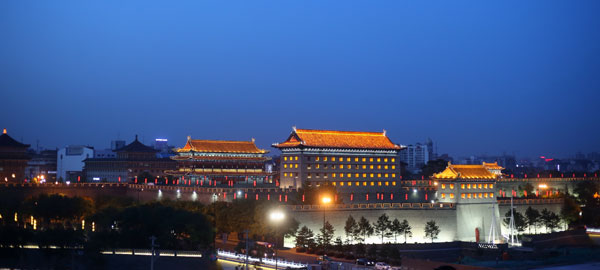 |
|
Xi'an in Shaanxi province offers visitors beautiful night views of the country's the most complete city wall. [Photo by Wang Jing/China Daily]
|
A relaxed visa policy makes it easy for tourists in transit to see China's ancient capital. Ma Lie reveals how to make the most of three days at the Silk Road's starting point.
Xi'an, capital of Shaanxi province and well-known as the hometown of the Qin Dynasty (221-206 BC) Terracotta Warriors, can now be enjoyed by transit visitors. The city will enact a 72-hour visa-free policy beginning June 1 for travelers from 51 countries. It is the first city in Northwest China, and the eighth in the country, approved to implement such a policy.
Transit passengers holding valid visas and a flight ticket to the third country are allowed to stay visa-free in the administrative areas of Xi'an and Xianyang, a city neighboring Xi'an and the location of Xi'an Xianyang International Airport, for three days, says Cui Guozheng, deputy director of the exit and entry administration bureau under the provincial public security department.
The 51 countries include most of Europe, six countries from the Americas, two Oceania countries and six Asian countries.
According to Cui, the landing day is not included in the 72 hours of the visa-free time: The clock starts at midnight at the end of the day they arrive at the airport.
At present, there are 12 international or regional air routes between Xi'an Xianyang International Airport and Helsinki (Finland); Seoul, Busan and Jeju (South Korea); Bangkok and Phuket (Thailand), Nagoya and Tokyo (Japan); Danang (Vietnam); and Siem Reap (Cambodia), as well as Hong Kong and Taipei. More routes will be added over the next 18 months.
Xi'an, known in China as "the eternal city", reflects the great changes of the nation just like a living history book. Called Chang'an in ancient times, Xi'an is one of the birthplaces of the ancient civilization in the Yellow River basin. During the 3,100-year development, 13 dynasties including Western Zhou (11th century-771 BC), Qin (221-206 BC), Western Han (206 BC-24 AD) and Tang (AD 618-907) placed their capitals here.
We Recommend:
